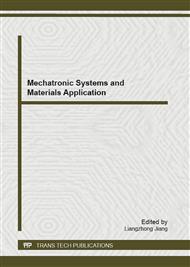[1]
D. Wang, Optimal design of structural support positions for minimizing maximal bending moment, Finite Elements in Analysis and Design. 43 (2006) 95–102.
DOI: 10.1016/j.finel.2006.07.004
Google Scholar
[2]
D. Wang, Optimization of support positions to minimize the maximal deflection of structures, International Journal of Solids and Structures. 61 (2004) 7445-7458.
DOI: 10.1016/j.ijsolstr.2004.05.035
Google Scholar
[3]
G. Prabhaharan, K. P. Padmanaban, R. Krishnakumar, Machining fixture layout optimization using FEM and evolutionary techniques. 32 (2007) 1090–1103.
DOI: 10.1007/s00170-006-0441-6
Google Scholar
[4]
R.J. Menassa, W.R. DeVries, Optimization methods applied to selecting support positions in fixture design, Transactions of the ASME. 113 (1991) 412-418.
DOI: 10.1115/1.2899715
Google Scholar
[5]
Tsai J S, Liao C L, Finite-element modeling of static surface errors in the peripheral milling of thin-walled workpieces, Journal of Materials Processing Technology. 94 (1999) 235-246.
DOI: 10.1016/s0924-0136(99)00109-0
Google Scholar
[6]
Jayaram S, Kapoor S G, DeVor R E, Estimation of the specific cutting pressures for mechanistic cutting force models, International Journal of Machine Tools & Manufacture. 41 (2001) 265-281.
DOI: 10.1016/s0890-6955(00)00076-6
Google Scholar
[7]
Larue A, Anselmetti B, Deviation of a machined surface in flank milling. International Journal of Machine Tools & Manufacture. 43 (2003) 129-138.
DOI: 10.1016/s0890-6955(02)00189-x
Google Scholar
[8]
Zhu R, Kapoor S G, DeVor R E, Mechanistic modeling of the ball end milling process fir multi-axis machining of free-form surfaces, Journal of Manufacturing Science and Engineering. 123 (2001) 369-379.
DOI: 10.1115/1.1369357
Google Scholar
[9]
Ratchev S, Govender E, Nikov S, et al, Force and deflection modeling in milling of Low-rigidity complex parts, Journal of Materials Processing Technology. 143-144(2003) 796-801.
DOI: 10.1016/s0924-0136(03)00382-0
Google Scholar
[10]
Ratchev S, Liu S, Huang W, et al, Milling error prediction and compensation in machining of low-rigidity parts, International Journal of Machine Tools & Manufacture, 44 (2004) 1629-1641.
DOI: 10.1016/j.ijmachtools.2004.06.001
Google Scholar
[11]
Ratchev S, Liu S, Huang W, et al, A flexible force model for end milling of low-rigidity parts, Journal of Materials Processing Technology. 153-154 (2004) 134-138.
DOI: 10.1016/j.jmatprotec.2004.04.300
Google Scholar
[12]
J. L. MARCELIN, Genetic optimization of supports in vibrating structures. Engineering Optimization. 34 (1) (2002) 101-107.
DOI: 10.1080/03052150210911
Google Scholar


